|
Örjan Martinsson
| |
|

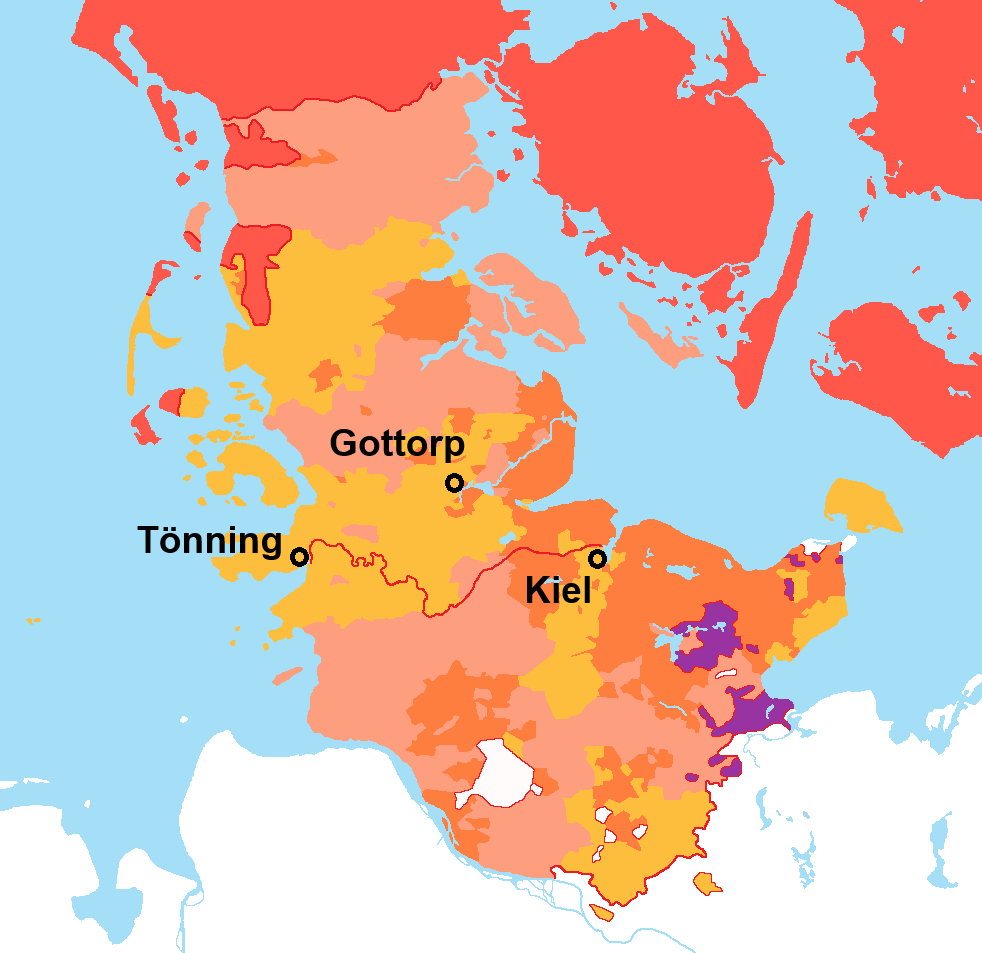
|
Duchies of
Schleswig and
Holstein
(two duchies ruled jointly by the Danish
king and the duke of Holstein-Gottorp)
 = Holstein-Gottorp's areas
= Holstein-Gottorp's areas
 = Jointly ruled areas
= Jointly ruled areas
 = The Danish king's areas
= The Danish king's areas
 = Kingdom of Denmark
= Kingdom of Denmark
 = Prince Bishopric of Lübeck
= Prince Bishopric of Lübeck
(ruled by members of the house of Holstein-Gottorp) |
The state commonly known as the
Duchy of Holstein-Gottorp was formed in 1544 as a result of a partition
treaty regulating the inheritance of the princes in the Danish royal house.
This meant that the two duchies of Schleswig and Holstein was to be ruled
jointly by the Danish kings and their relatives who belonged to the
collateral branch of Holstein-Gottorp (named after Gottorp castle in the
city of Schleswig). However, relations between these co-regents deteriorated
over time and eventually led to open enmity when Holstein-Gottorp allied
itself with Denmark's arch-enemy Sweden.
In 1674, Holstein-Gottorp had a
standing army of 3,000 men. But the following year, the duchy was occupied
by Denmark, which disbanded its army and used the soldiers to fill gaps in
the Danish army. In the Peace of Lund in 1679, the duchy was restored and a
new army was formed (with uncertain composition). However, it met the same
fate as its predecessor when the duchy was again occupied by Denmark in
1684-1689.
The Holstein army that existed
during the Great Northern War could therefore not trace its ancestry further
back than the Treaty of Altona on 20 June 1689, which restored
Holstein-Gottorp's independence for the second time. This army would then
grow to 5,300 men in 1703 and participated in the major battles during the
War of the Spanish Succession 1703-1714. However, Holstein-Gottorp's close
connections with Sweden would result in the duchy being occupied by Denmark
in 1714 and its army returning from the War of the Spanish Succession left
homeless. They therefore marched to Swedish Pomerania and went into Swedish
service. But when the anti-Swedish coalition captured Stralsund in 1715, the
last remnants of this incarnation of the Holstein army disappeared.
|
|
Campaigns of the Holstein Army
|
In Holstein-Gottorp |
In the Emperor's
service |
In the Maritime Power's
Service |
In Pomerania |
In Swedish Service
(in Pomerania) |
|
B = Blenheim |
M = Malplaquet |
O = Oudenarde |
R = Ramillies |
S = Stralsund
|
T = Tönning |
|
The Holstein army had
contributed troops to the German Imperial Army in 1693-1695 and then with
auxiliary troops in the service of the Maritime Powers in 1696-1697, so they
had war experience even before the Great Northern War began. But the real
baptism of fire for the Holstein-Gottorp army came when the Danish army
invaded their homeland in March 1700. The first drop of blood fell on 22
March when Danish troops entered the city of Schleswig and shot dead a
Holstein-Gottorp sergeant. However, the Holstein army had almost completely
retreated to the fortress of Tönning and its surroundings. The first serious
battles therefore took place when the Danes captured the redoubts that
protected the approaches to the peninsula where Tönning is located. After a
few days of stubborn defence, the Holsteins abandoned the redoubt in Husum
on 12 April. The next day, about 500 men (mostly Swedish soldiers) were
forced to surrender when the town of Friedrichstadt was captured by the
Danes. The last redoubt at Ramstedt and Schwabstedt was captured on 18 April
when its garrison of 300 men surrendered after a very short battle. Then it
was time for the main battle when, on 25 April, the Danes began shelling the
Tönning fortress, whose garrison had the following strength:
|
First Siege of Tönning
25 April – 1 June 1700
(15 April – 22 May according to
Swedish Calendar) |
|
|
Officers |
NCOs and Privates |
Leibregiment
Prince Christian August
Bautzen
The Duchess' Life Battalion
Vellingk
Liewen |
19
18
20
9
12
15 |
516
575
525
377
593
592 |
|
Sum Infantry |
93 |
3 178 |
|
Cavalry |
ca 400 |
|
Artillery |
ca 50 |
After a month of fierce fighting, Tönning was close to falling, but when
news came that a combined Swedish-Lüneburg relief army had crossed the
Holstein border, the Danes had to call off the siege. Only a small force was
left behind to block Tönning while the main Danish army marched south on 1
June to meet the new threat. Thereafter, the war in Holstein-Gottorp entered
a calm phase that lasted until the landing at Humlebæk which forced the
Danes to conclude the peace of Traventhal on 18 August.
After the brief war in 1700, the Holstein army gained further battle
experience by contributing over 3,000 men as auxiliaries in the War of the
Spanish Succession. Holstein regiments therefore took part in the famous
battles of Blenheim, Ramillies, Oudenarde and Malplaquet.
While the greater part of the Holstein army was still fighting in the War of
the Spanish Succession, in 1713 the Danes launched another siege of Tönning.
On February 15, the Holstein government had agreed to let in Magnus
Stenbock's Swedish army, which sought protection from a combined
Danish-Russian-Saxon army. However, it was only at the end of April that all
parts of the now roughly 10,000 strong Swedish army were gathered inside
Tönning's fortress. The anti-Swedish coalition began the actual siege by
starting to dig trenches on the night of 5 May. The Swedes, who were
hampered by a lack of provisions, surrendered on May 17 and began the
evacuation of its troops from the fortress on 20 May. However, the Holstein
troops remained and wanted to maintain control of their fortress. This was
accepted by the Russians and Saxons but not by the Danes who saw the
Holstein government's breach of neutrality as a pretext to occupy all of
Holstein-Gottorp. However, the surrender conditions had meant that the Danes
had promised not to shell Tönning and that the trenches would be destroyed.
A regular siege of the Holstein garrison in Tönning could therefore not be
carried out, but instead there was a blockade where the Danes tried to
starve the Holstein force out.
|
Second Siege of Tönning
4 May 1713 – 8 February 1714
(23 April – 28 January according
to the Julian Calendar)
|
Leibregiment
Vellingk
Artillery |
1 100
600
100 |
|
SUM |
1 800 |
In addition to Tönning's
garrison of 1,800 men, there had been 150 men in the Gottorp castle which
was taken before Tönning and in addition there were 50 men on the island of
Heligoland which was conquered by the Danes in August 1714.
The siege of Tönning was very long and meant great suffering for both
soldiers and civilians. On 12 January 1714, only 900 men remained of the
garrison of which only a third were healthy, 300 men had deserted and the
rest had died. Over 700 civilians had died out of a total population of
about 3,000. On 8 February the garrison, granted free passage to Eutin,
surrendered. The city of Eutin was the seat of the Prince-Bishopric of
Lübeck which was ruled by the Duke of Holstein-Gottorp's uncle.
The Holstein regiments that had participated in the War of the Spanish
Succession were thus homeless when they ended their service with the
Maritime Powers on 1 September 1713. But the Swedish fortress of Stettin had
been subjected to a Russian siege in August-September 1713, which was ended
on the condition that the Swedes handed over the fortress to two neutral
powers who would manage it for the remainder of the Great Northern War (a
so-called sequester). These neutral states were Holstein-Gottorp and Prussia.
Two of the returning infantry regiments were therefore garrisoned in Stettin
in January 1714. But as Prussia wanted to keep Stettin forever, they joined
Sweden's enemies and the two Holstein regiments were disarmed and taken
prisoner in April 1715. In total, 34 officers and 698 NCOs and privates were
captured by the Prussians. On July 5 of the same year, however, 161 Holstein
soldiers were exchanged for Prussians who had been captured by the Swedes.
These Holstein soldiers then joined the other Holstein regiments from the
War of the Spanish Succession which had already entered Swedish service in
May 1714.
The remainder of Tönning's and Heligoland's garrisons were forced by the Danes in September
1714 to leave Eutin and these also then entered Swedish service. These
troops, which had consisted of about 950 survivors from Tönning and Heligoland, had then shrunk to only 26 artillerymen (of which three
officers) and 112 infantrymen (of which 15 officers) and a six-man strong
staff.
All in all, about 1,700 Holsteiners went into Swedish service and
they participated in the defence of Pomerania in 1715 and at least the
cavalry is likely to have fought in the Battle of Stresow. But when Stralsund
surrendered in December, even this last remnant of the Holstein army
disappeared. |
|
Holstein Army Organisation
When Holstein-Gottorp's
independence was restored with the Treaty of Altona on 20 June 1689, the
duke still had no troops of his own. At first, therefore, troops from Sweden
and Braunschweig-Lüneburg (future Hanover) were put in as a garrison as
protection against Danish aggression. These consisted of 3,400 men and were
divided into 1,962 Swedish infantry (18 companies), 509 Swedish cavalry (8
companies) and 901 Lüneburg infantry (8 companies). In the spring of 1690
most of this force left Holstein-Gottorp who had now created an army of his
own.
The newly formed Holstein army
in 1690-1695 had an official strength of 2,390 men divided into twenty
infantry companies of 110 men each and two cavalry companies of 65 men each,
as well as an artillery and fortification staff of 60 men. But only eight of
these companies were recruited by Holstein-Gottorp itself. Sweden had left
behind eight companies that went into Holstein service and a further six
companies were transferred from Brandenburg. The infantry companies were
organised into two equal-sized regiments, but this division was mostly
theoretical because in practice the army consisted of independent companies
that were distributed over two garrison districts, a larger one in Tönning
and a smaller one in Gottorp.
During the War of the League of
Augsburg, Holstein-Gottorp contributed troops to the German Imperial Army in
1693-1695. These consisted of a five-company strong battalion under the
command of lieutenant colonel von Bülow (which, however, was subordinate to
a Lüneburg corps) and fought in the Spanish Netherlands. This reduction in
the strength of the army in Holstein-Gottorp was compensated by the lease of
a dragoon regiment of six companies (500 men) from Denmark in September 1694
for a period of three years
In 1695, however,
Holstein-Gottorp's relations with Denmark deteriorated sharply, and at the
end of the year an extensive rearmament of the Holstein army began, which
was completed in the spring of 1696. A battalion had been borrowed from
Sweden in 1695 and another 26 new companies were recruited so that the
Holstein army doubled and became roughly 5,000 men strong. It was only now
that an actual division of the army into regiments was put into practice so
that it consisted of four infantry regiments plus a Swedish battalion and
two dragoon regiments (one of which was actually Danish) and an independent
cavalry company. Three regiments were however leased to the Maritime Powers
(England and the Netherlands) as an auxiliary corps in the War of the League
of Augsburg in 1696-1697, but these returned to Holstein-Gottorp during the
winter months.
Although the conflict with
Denmark escalated in 1697 when Danish troops entered Holstein territory in
May and razed its fortifications, the size of the Holstein army was
nevertheless reduced. The Danish dragoon regiment was returned the same year
and the following year one of the infantry regiments that had been part of
the Maritime Powers' Auxiliary Corps was disbanded, while the size of the
companies was reduced. The total strength was therefore reduced to 3,360
men. But in the summer of 1699 the army was reinforced with three more
Swedish battalions so that it once again had an official strength of just
over 5,000 men when the Danes started the war in March 1700. The three
remaining Holstein infantry regiments had the following organisation in
1699:
|
Infantry Organisation in 1699 |
|
Regimental Staff |
Musketeer Companyi |
Grenadier Company |
1 Colonel (none in Leibregiment)
1 Lieutenant Colonel (2 in Leibregiment)
1 Major
1 Judge-advocate (Auditeur)
1 Adjutant
1 Regimental Surgeon
4 Surgeon's assistants
1 Regimental drummer
6 Oboists
1 Provost (Gevaldiger)
2 Provost's assistants (stokkeknækte) |
|
1 Captain
1 Lieutenant |
|
1 Captain
1 Lieutenant |
2 Sergeants
2 NCOs |
4 Sergeants |
|
2 Drummers |
2 Pipers
2 Drummers |
4 Corporals
6 Gefreiters
72 Privates |
4 Corporals
48 Privates |
Sum: 20 men
Each regiment also had 2-4 ensigns |
Sum: 90 men
(Rank-and-file: 82 men) |
Sum: 62 men
(Rank-and-file: 52 men) |
Leibregiment had eight musketeer companies and two grenadier companies (868
men), Prince Christian August's Regiment hade seven musketeer companies and
one
grenadier company (711 men). Bautzen's Regiment had only eight
musketeer companies (720 men).
After the peace of Traventhal
on 18 August 1700, two of the Swedish battalions (Wismar governor's
regiment) returned to Wismar. However, the peace had confirmed
Holstein-Gottorp's right to have its own army and set a cap of 6,000 men for
it, which then became a goal Holstein-Gottorp tried to achieve. In
1701-1702, a new rearmament of the Holstein army was therefore begun, which
was expanded by three regiments, two of which were mounted, so that it
became 5,400 strong. The intention was probably to participate in the Great
Northern War with an auxiliary corps in Swedish service. But the duke's
death at the Battle of Kliszow in 1702 and the outbreak of the War of the
Spanish Succession in the same year changed these plans. Instead,
Holstein-Gottorp contributed a cavalry regiment to the German Imperial Army
and leased an auxiliary corps to the Maritime Powers consisting of two
dragoon regiments and two infantry regiments. The agreement with the
Maritime Powers also involved a reorganisation of the auxiliary corps
regiments, which also affected the other regiments because they had to give
up manpower in order for the auxiliary corps to reach the agreed size of
2,730 men.
Organisation for
Regiments in the Maritime Power's Service in 1703
| Dragoon Regiment: |
Staff 14 men, 8 companies with 64 men each (of
which three officers). |
In total: 526 men. |
|
Infantry Regiment: |
Staff 14 men, 1 grenadier- and 10 musketeer
companies
with
75 men each (of which three officers). |
In total 839 men. |
Remaining in the homeland were two infantry regiments as well as the two
Swedish battalions and the cavalry company. The latter, however, had been
reduced to just 30 men in 1703 and was disbanded two years later. One of the
infantry regiment was transferred in 1709 to the Maritime Power's auxiliary
corps, while the two dragoon regiments in this were merged in 1710.
After the death of Duchess Hedvig Sofia on 22 December 1708, the
Holstein-Gottorp government began a reduction in the size of the regiments
in order to save money. When the reorganisation was completed, the part of
Holstein-Gottorp's army that remained at home had a strength of 2,879 men.
But this strength was further reduced, as previously mentioned, by another
regiment (611 men) being leased to the Maritime Powers in April 1709.
However, a power struggle within the government led to its leading man
Magnus von Wedderkop being imprisoned in December 1709 and replaced by Georg
Heinrich von Görtz with the support of Commander-in-Chief Gerhard von
Dernath. The latter was a proponent of a 6,000-strong army and saw to it
that the troop reduction was reversed.
The troop reduction had not affected the two Swedish battalions as these
were paid for by the Swedish crown (more specifically the General
Government of Bremen-Verden). However, the uncertain situation that arose
when Denmark declared war on Sweden in 1709 resulted in the battalions being
transferred to Holstein pay in 1710 so that Denmark would not be able to use
them as a pretext to invade Holstein-Gottorp. However, this did not prevent
one of these battalions from returning to Swedish service in 1711 so that
Sweden could reinforce its garrison in Stade.
When the Holstein army was drawn into the Great Northern War again in 1713,
its army would shrink rapidly as a result of the setbacks until it was
disbanded entirely in December 1715.
Commander-in-Chief of the Holstein Army
1690-1697
1697-1706
1706-1715 |
Otto Johann von Grothusen
Johan Gabriel Banér
Gerhard von Dernath |
|
|
Uniforms in General and
Colours and Standards
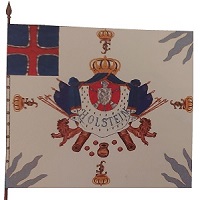 |
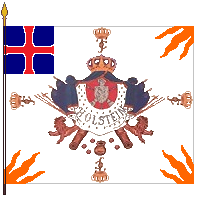 |
|
Colonel's colours for Holstein infantry regiments.
The one to the right is depicted in Höglund/Sallnäs' book and the one
to the left is described in the text of the same book. |
The Holstein infantry wore red coats and the cavalry blue coats with a
distinctive colour on facings for each regiment. There is no information
about the cut of the uniforms in my sources a part from Knüppel who mentions
that "the cut and colours (blue-red) were probably of the Swedish manner".
However, I have chosen to depict the Holstein regiments with uniforms of a
more generic style, although still approaching the Swedish style with
slightly smaller cuffs and turnbacks for at least the cavalry. Since the
uniform descriptions (taken from Höglund unless otherwise stated) do not
explicitly mention a collar on the coat, I have omitted it even though it
was standard in the Swedish army. In addition, I have provided the cuffs
with buttons, which was not the case for Swedish regiments.
Holstein officers wore a red and white sash as a sign of rank, but when in
the Maritime Power's service this sash may have been either orange (Netherlands)
or red (England). Swedish officers did not wear a sash.
In common with most armies, the regiments had a white colonel's
colour/standard and company colours/standards in the regimental colour.
However, note that Holstein infantry regiments had no more than 2-4 ensigns
in 1699. This may indicate that there were only two colours per battalion as
it was the ensign's task to carry the colour. The colours of the regular
infantry regiments would anyway have the Holstein cross flag in the upper
inner corner, the coat of arms of Holstein in the centre and flames in the
corners. According to Höglund's text, the colour of the flames should have
been orange for the colonel's colour and light blue for the company colours.
The pictures in the same book, however, show light blue flames for both the
colonel's (Bautzen's regiment) and the company colour (Prince Christian
August's regiment). Höglund's text really only describes the flames for
Bautzen's regiment, which had an orange distinctive colour, but states "same
as above" for the colours of Prince Christian August and Dobrokoffsky. To
further complicate matters, Steve Kling has depicted the Holstein flags in a
way that deviates greatly from Höglund/Sallnäs's book.
| |
According to
Höglund/Sallnäs |
According to
Steve Kling
(images only and no text
description) |
|
Company Colour's Colour |
Symbols |
Company Colour |
Deviations from Höglund/Sallnäs |
|
Leibregiment |
White |
Crowned CF in mirror monogram. In the
corners crowns between palm branches. the field strewn with open crowns. |
 |
Six "F's" in a cross pattern where half
are mirrored. Around the text "CUM CONSTANTIA ET LABORE". Crowns above
the F on each side and blue corner flames |
|
Bautzen |
Orange |
Holstein cross flag in upper inner
corner. Holstein's coat of arms in metal and colours, light blue corner
flames on the company colour and orange on the colonel's colour. |
 |
Same as Höglund/Sallnäs |
|
Dobrokoffsky |
Light grey |
Same as above. |
 |
Light blue company colours with orange
corner flames. The colonel's colour has light blue corner flames. |
|
Prince Christian August |
Blue |
Same as above. |
 |
Yellow company colour. Extra symbols
around Holstein's coat of arms that I cannot decipher (CA monogram?) |
|
Dragoner-Garde |
White with silver fringe |
Coat of arms of Holstein |
 |
Red company colour and gold fringe on all
colours. |
|
The Dragoon Regiment |
Blue with fringe (of gold?) |
CF monogram below ducal crown, all in
gold. |
 |
Same as Höglund/Sallnäs |
|
The Cavalry Regiment |
Blue with gold fringe |
CF monogram under ducal crown and motto
"CUM CONSTANTIA ET LABORE" in gold. |
 |
No motto. |
The biggest difference between
Höglund/Sallnäs and Kling is the Leibregiment's colour, which has no
similarities at all. But since Höglund/Sallnäs' colour has a CF monogram, it
must refer to the time 1702-1715 when Carl Friedrich was duke, while the
letter F which appears frequently in Kling's colour should mean that it is
from the reign of Friedrich IV 1694-1702 . The same explanation could be the
reason for the differences for the Dragoner-Garde's colours and possibly
also Prince Christian August's regiment. However, this is a less likely
explanation for the differences for Dobrokoffsky's regiment, which was
raised in 1701. It is possible that this has been a misunderstanding which
has caused light grey to become light blue instead. |
|
Artillery
In 1699, the artillery
consisted of 56 men distributed at Tönning (48) and Gottorp (8 men). In
1703, the number had increased to about 140 men. and in 1709 it consisted of
133 men. When the Holstein army was forced to leave Eutin in September 1714,
only 26 artillerymen remained, of which three were officers
According to Steve Kling, who
is referencing Augustus Kuhn, the artillerymen had a hat with white lace, a
red neckcloth, grey coats with pewter buttons and grey cuffs and stockings,
and a leather waistcoat and leather trousers.
|
|
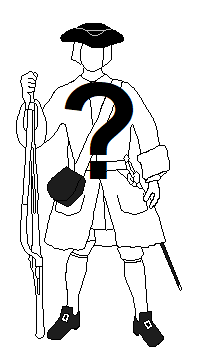
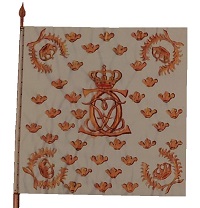 Leibregiment zu Fuss Leibregiment zu Fuss
(Life Regiment on Foot)
| 1695 |
Christopher von der Meden
Thielemann Andreas Bergholtz |
| 1701 |
Johan Gabriel Banér |
| 1706 |
Valentin Johan Daldorf |
| 1708 |
Joachim von Grumbkow |
| 1714 |
A. Koskull |
Formed in 1695, it initially consisted of two independent battalions under
the command of lieutenant colonels von der Meden and Bergholtz. Each
battalion had one grenadier and four musketeer companies (a total of 868
men). In 1703 it transferred men to the regiments that went into Dutch
service and subsequently came to consist of one grenadier and eight
musketeer companies.
Daldorf, who became its colonel in 1706, took part in Charles XII's campaign,
which meant that the actual regimental commander was lieutenant colonel
Azarias Franz Hercules.
A further reduction in the regiment's strength took place in early 1709 when
it was reduced to six companies (611 men in total). At the end of the same
year, however, there was a change of power in Holstein-Gottorp's government
which resulted in the Leibregiment being expanded to 12 companies of 100 men
each.
After Tönning's capitulation, the remaining Holstein troops (about 900 men)
were taken to the Prince-Bishopric of Lübeck. This force, which consisted
mainly of the Leibregiment, had by September 1714 shrunk to only 26
artillerymen and 112 infantrymen. In the same month, the Danes forced them
out of the prince-bishopric and they instead marched to Pomerania where they
entered Swedish service. In October 1715 the Leibregiment had an effective
strength of 19 officers, 40 non-commissioned officers, 8 games and 149
privates. These were then captured when Stralsund surrendered in December
1715.
Uniforms
Its uniform is completely unknown and Höglund has specified two different
speculative uniforms in part 1 and part 2 of his uniform trilogy. First he
stated that it should have been similar to the Dragoner-Garde's uniforms but
with a hat instead of a bearskin cap (that is, blue coat with red flaps). He
then changed his mind and wrote in part 2 "red with white spreads?".
Personally, I think that the Dragoner-Garde uniforms can still be a good
guide because, according to Steve Kling, both units had red company colours
(before they got Höglund's white colours?). This could indicate red facings.
The Dragoner-Garde also had a red coat before 1702 and then a blue coat, and
perhaps the Leibregiment also changed its coat colour. |
|
Prince Christian August's Infantry Regiment
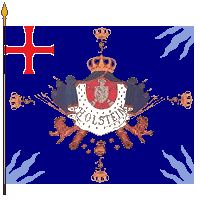
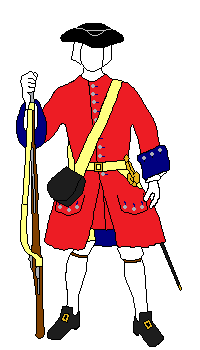 (Also
called the Administrator's Regiment from 1702) (Also
called the Administrator's Regiment from 1702)
|
? |
Otto Reventlow (killed in 1700) |
|
1703 |
Hans Albrecht von Barner |
|
1714 |
J. W. Delwig |
Formed in 1695 and was in
1696-1697 a part of the auxiliary corps in the service of the Maritime
Powers. At home in Holstein, in 1699 it consisted of one grenadier and seven
musketeer companies (711 men in total). It was expanded with three musketeer
companies in 1703 when it entered Dutch service (in total 839 men). When the
War of the Spanish Succession ended, the regiment left Dutch service and was
transferred to Swedish Pomerania in May 1714 where it entered Swedish
service. It then consisted of 430 men distributed among six companies. By
October 1715 it had an effective strength of 19 officers, 28
non-commissioned officers, 18 musicians and 515 privates. The regiment was
then captured when Stralsund surrendered in December 1715.
In the battle of Malplaquet in 1709, a Holstein regiment named Grothusen
took part. By the method of exclusion, this must have been Prince Christian
August's regiment, although Höglund has listed a Grothusen as commander of
Bautzen's regiment from 1708 (which also took part in the battle but was
named Hercules).
Uniforms
Privates: black hat without lace, red coat
with pewter buttons, blue lining and cuffs, red vest, leather breeches,
white stockings, white neckcloth.
Musicians: as privates, but with red
breeches and blue lace on cuffs, pocket flaps, edges and sleeves.
NCOs: as privates but with silver lace on
hat and cuffs.
Officers: as privates but with red breeches,
red-white sash, hat with gold lace, gilded buttons and button holes, seams
and pocket flaps decorated with gold lace.
What is reported above is mainly Höglund's general descriptions for the
Holstein infantry regiments from part 2 of his trilogy. However, in Part 1
which only describes the uniform of one Holstein infantry regiment, namely
this one, he specifies the red colour as carmine and states that the
stockings were grey. For the drummers, he then wrote that they probably had
silver buttons. |
|
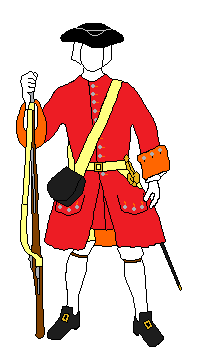
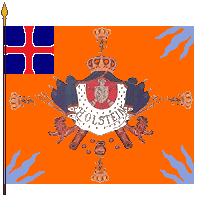 Bautzen's Bautzen's
Infantry Regiment
| 1695 |
Daniel von Bautzen |
| 1701 |
Magnus Blixencrone |
| 1702 |
Carl Johan Aderkass |
| 1709 |
Azarias Franz Hercules |
| 1709 |
Rumohr |
Formed in 1695 and consisted of
8 musketeer companies (720 men in total). It was expanded with one grenadier
and two musketeer companies in 1703 when it entered Dutch service (in total
839 men). When the War of the Spanish Succession had ended, the regiment
left Dutch service and was transferred to Stettin in January 1714 which was
then to be administered jointly by Holstein-Gottorp and Prussia. It then
consisted of only about 330 men distributed among six companies. In April
1715 the regiment was disarmed by the Prussians who took them prisoner.
Uniforms
Privates: black hat without lace, red coat
with pewter buttons, orange lining and cuffs, red vest, leather breeches,
white stockings, white neckcloth.
Musicians: as privates, but with red
breeches and orange lace on cuffs, pocket flaps, edges and sleeves.
NCOs: as privates but with silver lace on
hat and cuffs.
Officers: as privates but with red breeches,
red-white sash, hat with gold lace, gilded buttons and button holes, seams
and pocket flaps decorated with gold lace. |
|
Düring's Infantry Regiment
Formed in 1695 and included in the auxiliary corps that was in the
service of the Maritime Powers in 1696-1697. Returned to
Holstein-Gottorp, it was disbanded in 1698. Uniform and colour unknown. |
|
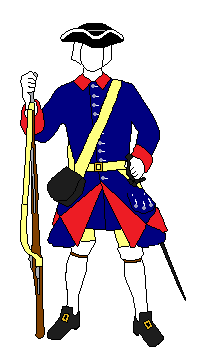
|
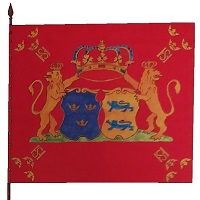
Company colour according to Höglund/Sallnäs. The
colonel's colour was the same but white instead of red |
The Duchess' Life Battalion
(Wismar Garrison Regiment)
Philip Christian Mardefelt (1699)
Bendix Friedrich von Rumohr (1709)
Five musketeer companies (545 men) belonging to Wismar Garrison Regiment and
loaned to Holstein-Gottorp in 1695. Got its name in 1698 when Charles XII's
sister Hedvig Sofia married Duke Friedrich IV. Was paid for by Sweden until
1710. Again in Swedish service when it was transferred to Stade's garrison
in July 1711 and ended up in Danish captivity when this fortress fell in
September 1712.
Regimental staff: 1 judge-advocate, 1
chaplain, 1 battalion clerk, 1 provost. Musketeer
company: 1 captain, 1 lieutenant, 2 sergeants, 2 non-commissioned
officers, 2 drummers, 6 corporals, 8 gefreiters, 86 privates (the colonel's
company also had an ensign).
Wismar Garrison Regiment in 1703 and 1706 had a uniform that looked like the
picture on the left. However, the vest's colour is a guess as information
about it is missing. |
|
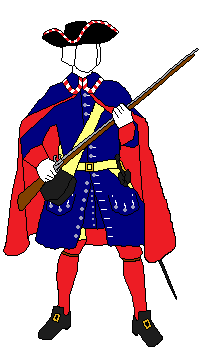 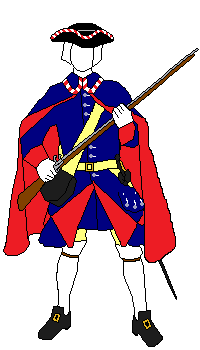 Vellingk's
Battalion Vellingk's
Battalion
(Stade Garrison Regiment)
Six companies (in total 642 men) under the command of Bogislaw von Rosen
in 1709.
Was transferred to
Holstein-Gottorp from Swedish service in July 1699 but was paid for by
Sweden until 1710. Seems to have been disbanded after the capitulation in
Tönning in 8 February 1714 (merged with the Leibregiment?)
The pictures show how the uniforms of the Stade garrison regiment looked in
1695, respectively 1704 and 1710. The colour of the vest is not mentioned in
1695, while the hat lace and the collar of the cloak are not mentioned for
the later uniform. However, the Provost had such lace in 1704/1710 so it
seems that the regiment did not change these details. The provost's
buttonholes were also white, and I guess that also applied to the privates. |
|
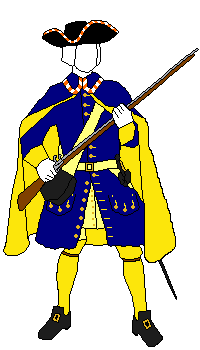 Liewen's Liewen's
Infantry Regiment
(Wismar Governor's Regiment)
The entire regiment was loaned to Holstein-Gottorp in July 1699 under
the command of lieutenant colonel Hempel. They formed the majority of a
force of between 500 and 600 men defending the town of Friedrichstadt
and which surrendered to the Danes in April 1700. The Danes then also
captured two of its colours which were described as blue and white "rutenweise".
The regiment returned to Wismar after the Peace of Traventhal. It was
then captured when Wismar surrendered in April 1716.
The uniform on the left is reported for the year 1699. |
|
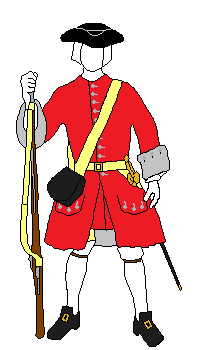 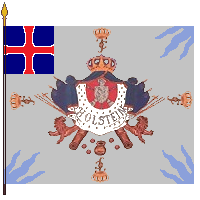 Dobrokoffsky's Dobrokoffsky's
Infantry Regiment
|
1701
1703 |
Hans Albrecht von Barner
Rudolf von Dobrokoffsky |
One grenadier and nine
musketeer companies (mustered 20 December 1701). Transferred men to the
regiments which went into Dutch service in 1703 and then came to consist of
one grenadier and eight musketeer companies. In 1709 the regiment was
reorganised into six companies (a total of 611 men). Commanded by Azarias
Franz Hercules, it entered Dutch service in April 1709. When the War of the
Spanish Succession had ended, the regiment left Dutch service and was
transferred to Stettin in January 1714 which was then to be administered
jointly by Holstein-Gottorp and Prussia. It then consisted of only about 330
men distributed among six companies. In April 1715 the regiment was disarmed
by the Prussians who took them prisoner.
Uniforms
Privates: black hat without lace, red coat
with pewter buttons, light grey lining and cuffs, red vest, leather breeches,
white stockings, white neckcloth.
Musicians: as privates, but with red
breeches and light grey lace on cuffs, pocket flaps, edges and sleeves.
NCOs: as privates but with silver lace on
hat and cuffs.
Officers: as privates but with red breeches,
red-white sash, hat with gold lace, gilded buttons and button holes, seams
and pocket flaps decorated with gold lace.
Steve Kling states that the regimental colour was white (instead of Höglund's
light grey). |
|
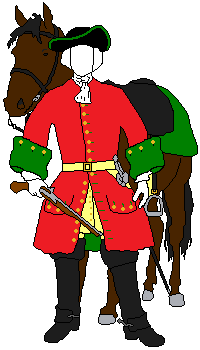 Holstein Holstein
Dragoon Regiment Christian Ditlev Reventlow
A Danish regiment which was raised in 1685 and which in 1694 was transferred
to Holstein-Gottorp for a period of three years. Back in Danish service, it
was then disbanded in 1701 and its men were transferred to Livregiment
Dragoons. The regimental commander Reventlow was the same man who in
1709-1710 led the Danish army during the campaign in Scania.
The uniform is described as a red coat with green facings. |
|
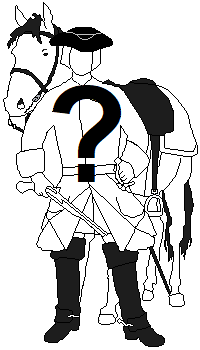 Trabanten-Garde Trabanten-Garde
(Drabant Guards)
Major Behr
Formed in 1695, it consisted in 1699 of 1 major, 2 lieutenants, 2 NCOs, 1
farrier, 3 first corporals, 3 second corporals and 72 trabants (in total 84
men). In 1703, Trabanten-Garde consisted of 114 men, which, however, was
reduced to only 30 men at the end of the year and was completely disbanded
two years later.
The uniform is unknown, but Höglund speculates that they may have resembled
the Swedish Drabant Corps. Blue, white and red were Holstein-Gottorp's
colours and it is likely that a high-status unit such as this should have
included them. Compare with the Dragoner-Garde. |
|
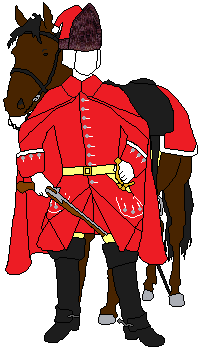
Uniform before 1702 |
|
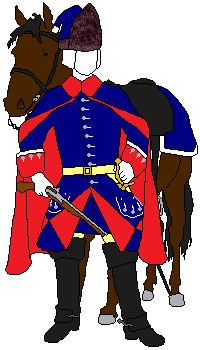
Uniform after 1702 |
Dragoner-Garde
(Dragoon Guards)
1703 Gerhard von Dernath (von der Nath)
Was recruited during the winter of 1695-96 to form part of the auxiliary
corps in the service of the Maritime Powers during the War of the League of
Augsburg.
Consisted of 6 companies in 1699 and a staff which included: 1 colonel, 1
lieutenant colonel, 1 major, 1 regimental quartermaster, 1 judge-advocate, 1
regimental surgeon with 2 assistants, 1 kettle-drummer, 6 oboists, 1 provost
with assistant. Each company consisted of 1 captain, 1 lieutenant, 1 ensign,
1 NCO, 3 corporals, 1 farrier, 2 drummers and 40 dragoons (exceptions were
the lieutenant-colonel's and major's companies, which lacked captains). The
total strength was 315 men.
It was reorganised and increased to 8 companies in 1703 when it entered
English service. When the War of the Spanish Succession ended, the regiment
left English service and was transferred in two instalments (January and
May 1714) to Swedish Pomerania, where it went into Swedish service in May.
The regiment then consisted of 12 companies with a total of 770 men (Baudissin's
dragoon regiment had been merged with the Dragoner-Garde in 1710). The
regiment had an effective strength of 562 privates in June 1715 and was
captured in December 1715 when Stralsund surrendered.
Uniforms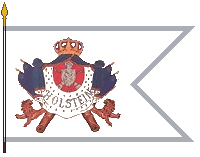
Privates: bearskin cap, blue coat with
pewter buttons, red lining and cuffs, white lace on edges, cuffs,
buttonholes and pocket flaps, blue vest, straw-coloured breeches, blue cloak
with red collar, blue shabraque and pistol covers with white edge.
Drummers:
hat with silver lace and red and white pom-pom, blue coat richly decorated
with silver lace in seams, edges, cuffs, pocket flaps and on sleeves, blue
vest with silver lace and leather breeches.
NCOs: bearskin cap, blue coat with silver
buttons, red lining and cuffs,
white lace on edges, cuffs, buttonholes, galloons and pocket flaps, blue
vest with silver lace, leather breeches.
Officers: hat with silver lace or bearskin
cap with red tassel, blue coat with silver buttons, red lining and cuffs,
richly decorated with silver lace on edges, seams, buttonholes and on pocket
flaps, white neckcloth, blue vest with silver lace, blue breeches, blue
cloak with red collar furnished with silver lace, blue shabraque and pistol
covers with silver lace.
The above-mentioned information from Höglund apparently applies to the
period 1702-1715. Prior to this they had (according to Steve Kling
referencing Augustus Kuhn and Robert Hall) a uniform consisting of a red
coat with pewter buttons and red facings, leather-coloured breeches and a
red shabraque with white trim. |
|
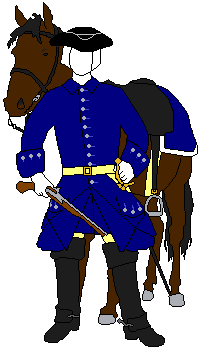 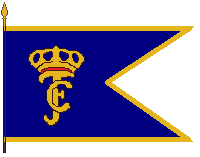 The
Dragoon Regiment The
Dragoon Regiment
1701
1702 |
Thielemann Andreas von Bergholtz
Wulf Heinrich von Baudissin |
Six companies (mustered 21 July 1701). Expanded with two companies in 1703
when it entered English service (total strength 526 men). It was disbanded
in 1710 and merged with the Dragoner-Garde
Uniforms
Privates: black hat, blue coat with pewter
buttons, blue lining and cuffs, blue vest, leather breeches. Blue shabraque
with white edge.
Drummers: all blue uniform, silver lace and
red and white plume on hat.
NCOs: as the privates but with
silver lace on hats and cuffs.
Officers: all blue uniform with silver
buttons and silver lace on hat, cuffs, edges, pocket flaps and in the seams. |
|
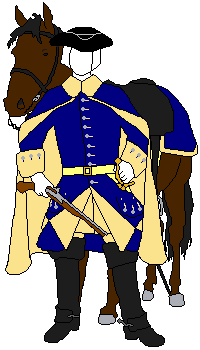 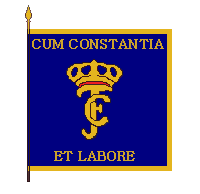 The
Cavalry Regiment The
Cavalry Regiment
|
1703 |
Heinrich von der Osten |
|
1706 |
Otto Friederich von Görtz |
|
1708 |
Johann Dietrich Grothusen (died in 1708) |
|
1708 |
Azarias Franz Hercules (killed in 1709) |
|
1709 |
Hans Julius von Kirchbach |
|
1715 |
O. F. von Düring |
Heinrich von der Osten signed a contract in 1701 to raise a dragoon
regiment, but the six companies were not fully recruited until 1703 and then
it was designated as a cavalry regiment. Although later on, this regiment
would sometimes be called a dragoon regiment.
As early as 1703, two companies were transferred to Baudisson's Dragoon
Regiment, which was reinforced to be sent as auxiliary troops to the
Maritime Powers. The remaining four companies of 55 men each and the staff
of 7 men (a total of 227 men) became in July Holstein-Gottorp's contribution
to the German Imperial Army during the War of the Spanish Succession.
Two independent dragoon companies (of three officers and 57 men) were raised
in 1704 under the command of Otto Friedrich von Görtz, but they were
incorporated into von der Osten's regiment in 1706, which was not long
afterwards bought by Görtz. It then came to consist of 342 men. The regiment
was again at home in 1706-1708 and at the end of 1709. In the latter year it
was temporarily reduced to four companies but when the War of the Spanish
Succession ended it consisted of six companies with a total of about 340
men. It was transferred to Swedish Pomerania in May 1714 and entered Swedish
service. It had an effective strength of 335 privates in June 1715 and was
captured in December 1715 when Stralsund surrendered.
Uniforms
Privates: hat without lace, blue coat with
pewter buttons, paille-yellow lining, cuffs, vest and breeches. blue cloak
with paille-yellow collar, blue shabraque and pistol covers with paille-yellow
edge.
NCOs: hat med silver lace, white neckcloth, blue
coat with pewter buttons, paille-yellow lining, cuffs, vest and breeches, silver
lace on cuffs (vest and breeches of leather or cloth), blue shabraque
and pistol covers with paille-yellow edge.
Trumpeters: like NCOs but with silver lace
on the coat's sleeves.
According to Steve Kling, Augustus Kuhn specified blue facing colour instead
of paille-yellow (an earlier uniform?). |
|
References
Höglund, Lars-Eric – Sallnäs, Åke. Stora nordiska kriget 1700-1721 - Fanor och uniformer.
Karlstad (2000)
Höglund, Lars-Eric – Sallnäs, Åke. Stora nordiska kriget 1700-1721, II.
Karlstad (2003)
Kling, Steve. The Army of Holstein-Gottorp in the Great Northern War.
(article in GNW Compendium) St. Louis (2015)
Knüppel, Günter. Das Heerwesen des Fürstentums
Schleswig-Holstein-Gottorf 1600-1715. Neumünster (1972)
MacDowall, Simon. Malplaquet 1709 - Marlborough's Bloodiest Battle.
Oxford (2020
McNally, Michael. Ramillies 1706 - Marlborough's tactical masterpiece.
Oxford (2014)
Tessin, Georg. Die Regementer der europäischen Staaten im Ancien
Regime. Osnabrück (1986)
Tincey, John. Blenheim 1704 - The Duke of Marlborough's Masterpiece.
London (2004)
Tuxen, A. P. - With-Seidelin C. L. Bidrag til den store nordiske krigs
historie. Copenhagen (1899-1934) |
|

